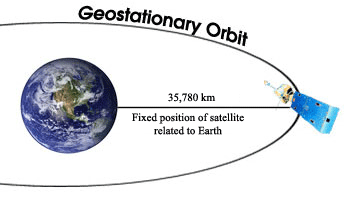This equates to an orbital speed of 3 07 kilometres per second 1 91 miles per second and an orbital period of 1 436 minutes one sidereal day.
Geostationary satellite time period.
The earth actually rotates 366 25 approx times in a year not 365 25.
23 hours and 56 minutes.
Geo means earth and stationary means at rest.
A geostationary orbit can be achieved only at an altitude very close to 35 786 kilometres 22 236 miles and directly above the equator.
Along with this orbital period requirement to be geostationary as well the satellite must be placed in an orbit that puts it in the vicinity over the equator.
A geostationary satellite is an earth orbiting satellite placed at an altitude of approximately 35 800 kilometers 22 300 miles directly over the equator that revolves in the same direction the earth rotates west to east.
This means something which is stationary.
Using the equation for periods you see that.
Can you find the distance a stationary satellite needs be from the center of the earth that is the radius to stay stationary.
If you think the earth s rotation period is 24 hours exactly you have forgotten that that is relative to the sun.
They also rotate around earth with time period of 24 hours.
But we are actually moving around the sun.
At this altitude one orbit takes 24 hours the same length of time as the earth requires to rotate once on its axis.
It has the same period as the earth s rotation.
The time period of a geostationary satellite is 24 h at a height 6r e r e is radius of earth from surface of earth.
Appear to be stationary with respect to earth.
The time period of another satellite whose height is 2 5 r e from surface will be.
The term geosynchronous refers to the satellite s orbital period which enables it to be with the rotation of the earth geo.
These two requirements make the satellite appear in an unchanging area of visibility when viewed from the earth s surface enabling continuous operation from one point on the ground.
























